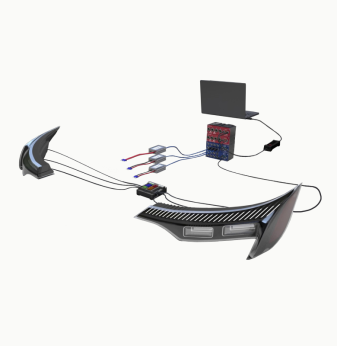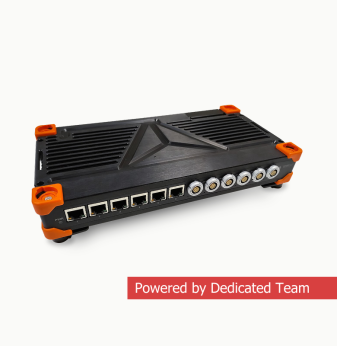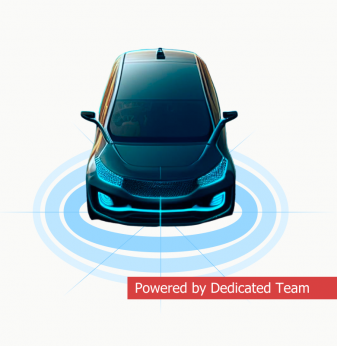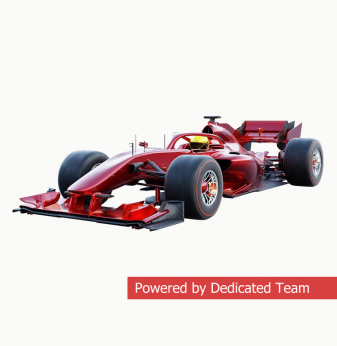Why Timing Matters: The Role of RTOS in Advanced Embedded Systems


When precision, reliability, and efficiency are critical to your business, real-time operating systems (RTOS) become indispensable. In automotive, healthcare, aerospace and industrial automation, they ensure that time-sensitive tasks are completed without unexpected delays and improving product performance and safety. In turn, this boosts customer satisfaction and reduces operational costs, giving businesses an edge over their competitors.
Table of contents
What is RTOS, and why is it so useful?
How to choose RTOS, bare metal or Linux RT?
Using RTOS brings long-term benefits by improving device responsiveness and security. Whether you are working with embedded systems, IoT devices or complex control systems, implementing RTOS makes your solutions more efficient and future-proof.
In this article, we explain how real-time operating systems work, explore the fundamentals of RTOS and its applications, and compare two widely used RTOS platforms – Zephyr and FreeRTOS.
What Is RTOS, and Why Is It So Useful?
An RTOS is a type of operating system designed to manage tasks that must be completed within a strict time frame. General-purpose operating systems (Windows or MacOS) prioritise multitasking and user interaction, whereas an RTOS focuses on completing tasks exactly when needed. The RTOS ensures this timely execution of operations, helping to maintain system efficiency.
An RTOS was created to manage hardware resources, perform activities within specific time restrictions, and guarantee that key procedures are finished on time. Here are some of its main features:
- Deterministic behavior. RTOS provides predictable response times, meaning that tasks will consistently be completed within a specified timeframe.
- Priority-based scheduling. Tasks are assigned priority levels: high-priority tasks are executed before lower-priority ones.
- Multitasking. An RTOS can handle multiple tasks simultaneously and switch between them based on their priorities for optimal resource utilisation.
- Fast dispatch latency. Switching time from one task to another is minimised in embedded real-time systems, enabling quick responses to events.
- Memory management. RTOS includes efficient memory management techniques to allocate and deallocate memory dynamically, prevent memory leaks and ensure that tasks have access to the necessary resources.
- Interrupt handling. An RTOS can respond to external events and interrupt quickly.
- Small footprint. Compared to general-purpose operating systems, RTOS typically occupies less memory and consumes fewer resources.
- Task synchronisation mechanisms. RTOS provides semaphores, mutexes, and message queues to coordinate task execution and resource sharing among multiple processes without conflicts.
- Modular design. Many RTOSs support modular development approaches for creating independent modules that can be tested individually before integration into the larger system.
RTOS are categorised based on timing constraints and the consequences of missing deadlines. Here are the three different types of RTOS and their typical applications:
Hard RTOS
These systems have strict timing requirements, where tasks must be completed within a defined time frame. Missing a deadline can lead to catastrophic failures. It is commonly used in critical applications such as medicine (pacemakers and infusion pumps), aerospace (flight control systems and avionics), and industrial automation (robotics and manufacturing systems that rely on precise timing for operations).

Pacemakers are implanted to treat symptoms caused by bradycardia (slow heart rate). The RTOS keeps the device running smoothly
Firm RTOS
This type also has deadlines that need to be met, but occasional missed deadlines do not result in severe consequences. However, missing deadlines can degrade system performance. You can find firm RTOS in applications where timely responses, such as multimedia and telecommunications, are important but not critical.
Soft RTOS
These systems provide a more relaxed approach to timing constraints. Tasks can miss deadlines without a significant impact on system functionality. It is suitable for applications where timing is less critical, including consumer electronics (smart home devices and appliances) and general computing multimedia systems.
Where Can You Use RTOS?
We encounter devices using RTOS in our daily lives, such as smart thermostats, fitness trackers, and game consoles. However, the application of these systems extends far beyond these familiar examples, covering a wide range of industries and technologies.
The system is essential for controlling avionics systems, satellite operations, drones and radar systems in the aerospace sector. Its deterministic behavior ensures critical safety and mission success tasks are executed within strict time constraints.
In the automotive industry, RTOS supports ADAS (advanced driver assistance systems), including lane departure warnings and collision avoidance, where real-time data processing is used for passenger safety and vehicle performance.
The healthcare and medical device industry relies on the system for devices like infusion pumps, respiratory systems, and patient monitors. Real-time processing ensures timely responses for patient safety and treatment accuracy.
In industrial automation, RTOS is used in PLCs (programmable logic controllers) to provide precise control and synchronisation of processes.
In telecommunications, RTOS manages network protocols and ensures real-time data transfers in video conferencing, online gaming, and streaming, where low latency is crucial for smooth communication.
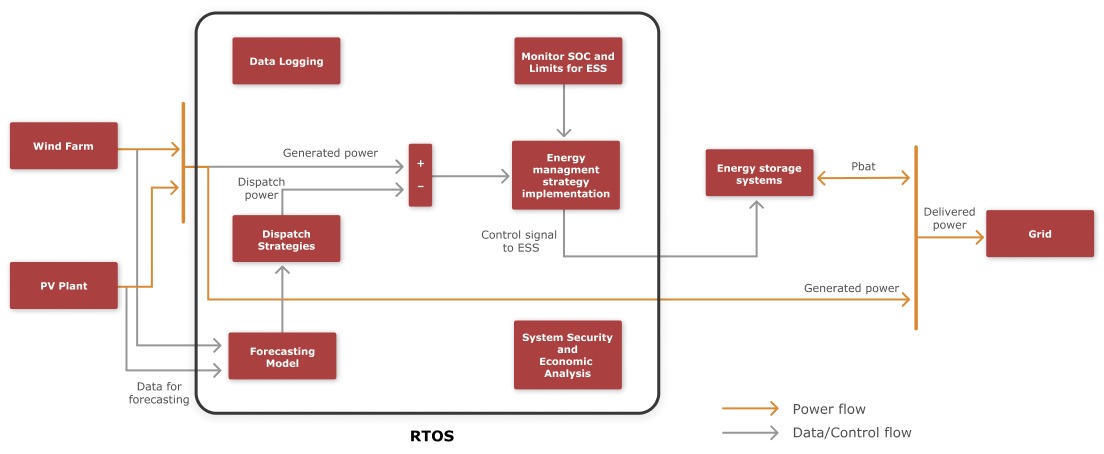
The structure of an energy management system. RTOS is used to ensure real-time control and monitoring of energy distribution
In finance and retail, particularly in high-frequency trading, RTOS helps systems react instantly to market changes, though some use non-RTOS solutions that still require real-time processing principles.
Embedded systems across various industries leverage RTOS for coordination of complex operations. In robotics, it allows mechanisms to respond dynamically to changing environments. RTOS in embedded systems also provides reliable performance for smart thermostats and automotive control systems.
How to Choose RTOS, Bare Metal or Linux RT?
The choice between bare metal, RTOS and Linux RT depends on the specific requirements of your project, including real-time performance, hardware constraints and complexity.
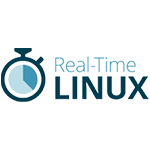
Linux RT refers to integrating real-time capabilities into the Linux operating system, enabling it to handle time-sensitive tasks with precision and reliability. This is achieved through various implementations, primarily the PREEMPT_RT patch, which modifies the standard Linux kernel to enhance its responsiveness for real-time applications.
The development of real-time capabilities in Linux has been ongoing for over 20 years. The PREEMPT_RT patch was created to integrate real-time features directly into the mainline kernel rather than maintaining a separate real-time kernel. As of the latest updates (kernel version 6.12), these real-time features have been officially included in the mainline Linux kernel.
RTOS is ideal when real-time precision and deterministic responses are essential. It excels at prioritising high-priority tasks and enables real-time responses to sensor inputs, interrupts and data processing. For example, an RTOS would control flight operations such as balance, sensor input management and motor adjustments in a drone.
Bare metal programming is best suited to applications that require direct access to hardware and minimal overhead. This approach is common for simple, low-level embedded systems with limited resources, such as small IoT devices or microcontroller-based applications. A temperature sensor in an IoT network that only needs to send temperature readings periodically is an ideal candidate for bare metal programming.
Linux RT is better for those needing Linux's power and flexibility with real-time capabilities. Adding real-time patches to the standard Linux kernel supports tasks with real-time constraints while maintaining Linux's full functionality. It's perfect for high-performance, multitasking applications that require real-time responses, such as multimedia servers managing live video streams with smooth encoding, networking, and storage.
How Does RTOS Work?
The most important function of an RTOS is its scheduling mechanism. RTOSs use a priority-based scheduling algorithm to assign tasks of different priorities based on their importance. For example, in an airbag system of a car, if a sensor detects a collision, deploying the airbag must take priority over all other ongoing processes, which is exactly what the RTOS guarantees.
RTOSs use two main types of scheduling: preemptive and cooperative. In preemptive scheduling, the system can interrupt a lower-priority task if a higher-priority task becomes ready to run. In contrast, cooperative scheduling requires tasks to voluntarily yield control back to the operating system, which is less common in real-time applications due to the possibility of delays.
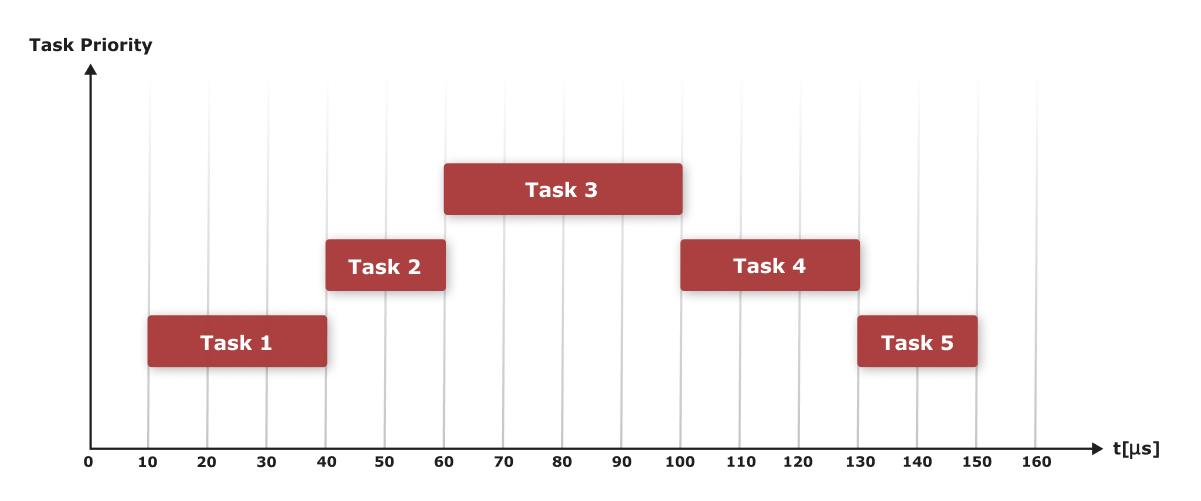
RTOS preemptive scheduling in automotive airbag systems. If a collision sensor detects an impact, deploying the airbag must interrupt any lower-priority processes
Also, RTOS could manage interrupts. When external events, such as sensor inputs, occur, the system can immediately pause the current task to handle the interrupt. This feature ensures the system can react instantly to critical events, such as stopping a machine when an emergency button is pressed.
Memory management in an RTOS is also optimised for real-time tasks. This system typically uses static memory allocation to ensure no delays occur due to memory management during execution. It is essential for systems that cannot afford even microsecond delays.
In addition to task scheduling, an RTOS often provides inter-task communication mechanisms, such as message queues, semaphores, and mutexes. These allow tasks and threads to communicate and synchronise efficiently without causing delays.
Let’s Compare: Zephyr RTOS vs. FreeRTOS
Zephyr RTOS and FreeRTOS are two real-time operating systems commonly used in embedded systems developed by Promwad engineers. Both have certain advantages and are suitable for various applications, but they also have their specific characteristics.
Zephyr RTOS
Zephyr RTOS, developed by the Linux Foundation, is a highly modular and scalable real-time operating system tailored for resource-constrained devices. Zephyr supports ARM, x86, RISC-V, ARC, and other architectures as an open-source solution. It is perfect for complex, multi-threaded applications that demand robust networking capabilities, strong security features, and modularity.
One of Zephyr's key strengths is its configurability, thanks to the Kconfig system, which allows developers to customise this RTOS by selecting only the features they need. In addition, Zephyr offers secure boot and TrustZone, it is essential for secure IoT devices. The system also provides extensive networking support with TCP/IP, 6LoWPAN, and Bluetooth.
Zephyr supports multi-core systems with native multi-processing capabilities and is suitable for complex applications. Moreover, its ecosystem is expanding rapidly, with backing from major industry players, leading to widespread adoption in IoT, industrial automation, and wearables.
Major chip vendors, including Intel, NXP, Nordic Semiconductor, and STMicroelectronics, support Zephyr. Nordic Semiconductor uses Zephyr for its nRF52 and nRF91 series of SoCs, which are popular for Bluetooth and cellular IoT devices. Intel supports Zephyr for its Quark microcontrollers, which are used in low-power IoT solutions.
| FreeRTOS | ThreadX | Zephyr | |
| File management | ✔ | ✔ | ✔ |
| USB | ✔ | ✔ | |
| TCP/IP | ✔ | ✔ | ✔ |
| MQTT | ✔ | ✔ | ✔ |
| HTTP | ✔ | ✔ | ✔ |
| GUI | ✔ | ✔ | |
| JSON | ✔ | ✔ | |
| LoraWAN | ✔ | ✔ | |
| AWS IoT | ✔ | ||
| Azure IoT | ✔ | ||
| Cryptogaphy | ✔ | ✔ |
Comparison of commonly used RTOSs
FreeRTOS
FreeRTOS, developed initially by Real Time Engineers Ltd. and now under Amazon Web Services (AWS), is one of the most widely adopted real-time operating systems, particularly in small, resource-constrained devices.
With a minimal memory footprint, FreeRTOS is highly suited for microcontroller-based environments with limited resources. In addition to its lightweight architecture, FreeRTOS benefits from a large and active developer community with support through tutorials, documentation, and forums, making it accessible to developers of varying skill levels.
FreeRTOS is also highly portable across platforms, including ARM Cortex-M, PIC, AVR, and RISC-V. Furthermore, its integration with AWS IoT services links to cloud-based data storage and processing, which makes FreeRTOS an excellent choice for IoT applications requiring reliable real-time processing combined with cloud infrastructure.
Texas Instruments, Microchip, NXP, and STMicroelectronics support FreeRTOS. It is often the go-to RTOS for microcontroller-based applications. Texas Instruments uses FreeRTOS in its SimpleLink microcontrollers, which are used in IoT and industrial applications. Microchip integrates FreeRTOS with its SAM and PIC32 microcontroller families, which are popular in embedded applications.
Case Studies
Let’s look on examples of real-time embedded systems in completed projects:
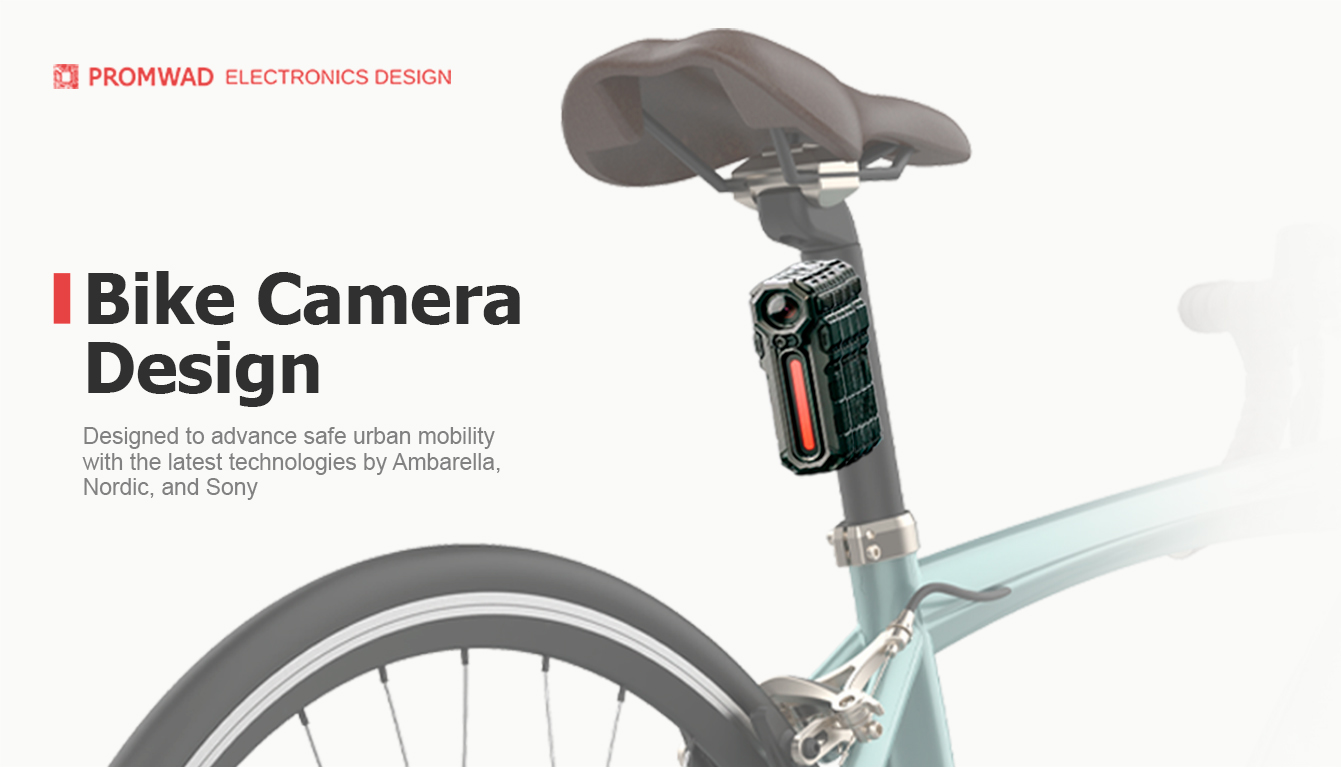
Cycling Dash Cam Design
Our team assisted a German startup in designing and preparing a new camera for cyclists for mass production. Our engineers were responsible for developing the product's hardware and low-level software.
The system includes devices with an integrated dashboard camera, travel distance measurement, daytime running and reversing lights, a crash detector, and a ride tracker.
Key features:
- Bluetooth module by Nordic (Zephyr RTOS)
- Ambarella H32 module with ThreadX and Linux
- Sony imx390 image sensor
- Quectel L76-LB GNS module
Fleet Vehicle Tracking Device
We engineered a fleet vehicle tracking device equipped with alarms to prevent theft or damage. The device can be installed as a hidden one.
The functions include geofencing, tracking, over-speed alerts, aggressive driving and extreme event detection, ignition control, night mode, device diagnostics, and protection against vehicle activation or movement.
Key features
- Main processor: Nordic nRF52840
- Telit w910 LTE-M + 2G modem
- Bluetooth and various sensors
- Works with Gurtam–Wialon on the server side
***
A diverse range of industries and electronics require accuracy and reliability, and RTOS remains the backbone of mission-critical systems in various sectors. Ensuring safety in medical devices or improving vehicle performance with ADAS – RTOS provides the real-time responsiveness these systems require.
If your business needs to develop embedded solutions that rely on time and efficiency, the Promwad team is ready to help. We will support you in selecting the right RTOS platform and in all stages of developing specialised embedded systems.
Contact us today to discuss your RTOS-based project and how we can help bring your idea to life!
Our Case Studies in Firmware Development

